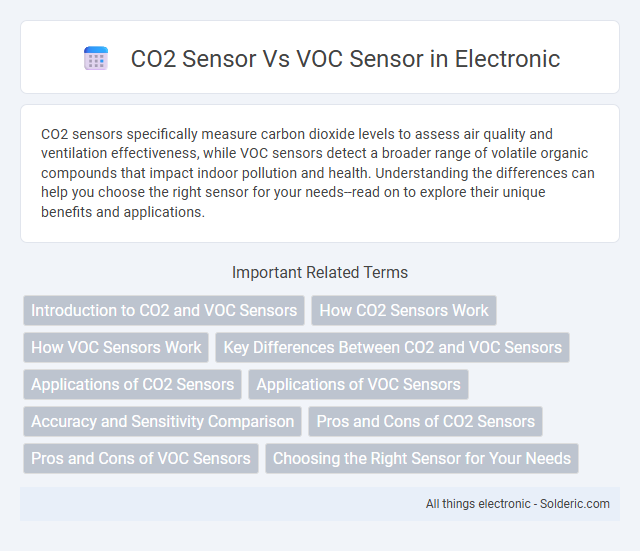CO2 sensors specifically measure carbon dioxide levels to assess air quality and ventilation effectiveness, while VOC sensors detect a broader range of volatile organic compounds that impact indoor pollution and health. Understanding the differences can help you choose the right sensor for your needs--read on to explore their unique benefits and applications.
Comparison Table
| Feature | CO2 Sensor | VOC Sensor |
|---|---|---|
| Measurement Target | Carbon Dioxide (CO2) Gas | Volatile Organic Compounds (VOCs) |
| Common Applications | Indoor air quality, HVAC control, greenhouse monitoring | Air pollution detection, indoor air quality, chemical exposure monitoring |
| Sensitivity | Measures CO2 concentration in ppm (parts per million) | Measures total VOC concentration, often in ppb (parts per billion) |
| Technology Used | NDIR (Non-Dispersive Infrared) sensors | Metal oxide semiconductor or photoionization detectors |
| Response Time | Typically 20-60 seconds | Typically faster, seconds to minutes |
| Calibration Frequency | Periodic calibration required for accuracy | Frequent recalibration needed due to cross-sensitivity |
| Cross-Sensitivity | Low, specific to CO2 gas | High, affected by multiple VOCs and environmental factors |
| Cost Range | Moderate to high | Low to moderate |
Introduction to CO2 and VOC Sensors
CO2 sensors detect the concentration of carbon dioxide in the air, crucial for monitoring indoor air quality and ventilation efficiency, especially in environments like offices and schools. VOC sensors measure volatile organic compounds emitted from household products, paints, and cleaning agents, providing insight into chemical pollutants that can affect health and comfort. Understanding the differences between CO2 and VOC sensors helps you choose the right device for targeted air quality monitoring.
How CO2 Sensors Work
CO2 sensors measure carbon dioxide concentration by using infrared (NDIR) technology, which detects the amount of IR light absorbed by CO2 molecules in the air, providing accurate real-time readings essential for monitoring indoor air quality. In contrast, VOC sensors identify volatile organic compounds by detecting changes in electrical resistance or capacitance caused by the presence of various organic chemicals, not specifically measuring carbon dioxide levels. Understanding how CO2 sensors work helps you choose the right device for precise ventilation control and maintaining healthy indoor environments.
How VOC Sensors Work
VOC sensors detect volatile organic compounds by measuring the concentration of gases emitted from materials such as paint, cleaning products, and building materials. These sensors typically use metal oxide semiconductor (MOS) technology, where gas molecules interact with the sensor's surface, causing changes in electrical resistance that are converted into measurable signals. Understanding how VOC sensors work helps you monitor indoor air quality more effectively compared to CO2 sensors, which primarily measure carbon dioxide levels.
Key Differences Between CO2 and VOC Sensors
CO2 sensors specifically measure carbon dioxide concentrations, providing accurate readings of indoor air quality related to ventilation and occupancy levels. VOC sensors detect a broad range of volatile organic compounds emitted from paints, cleaning agents, and other sources, offering a more general indication of air pollution and chemical exposure. Your choice between these sensors depends on whether you need precise CO2 monitoring or comprehensive detection of various chemical pollutants in the environment.
Applications of CO2 Sensors
CO2 sensors are widely used in indoor air quality monitoring systems to maintain optimal ventilation in commercial buildings, schools, and healthcare facilities. They help reduce energy consumption by controlling HVAC systems based on real-time carbon dioxide concentration levels. These sensors are also critical in agriculture to optimize plant growth in greenhouses by monitoring CO2 enrichment.
Applications of VOC Sensors
VOC sensors are widely used in indoor air quality monitoring, detecting harmful organic compounds emitted from paints, cleaning agents, and building materials to ensure a healthy environment. They are essential in industrial safety for detecting chemical leaks and controlling emissions from manufacturing processes. VOC sensors also play a crucial role in smart home systems by optimizing ventilation and air purification based on pollutant levels.
Accuracy and Sensitivity Comparison
CO2 sensors typically offer higher accuracy in measuring carbon dioxide concentrations, crucial for indoor air quality monitoring and HVAC system efficiency. VOC sensors detect a broader range of volatile organic compounds with greater sensitivity, making them suitable for identifying low-level chemical pollutants and odors. Your choice depends on whether precise CO2 quantification or comprehensive detection of airborne chemicals is the priority.
Pros and Cons of CO2 Sensors
CO2 sensors offer precise measurement of carbon dioxide concentration, making them ideal for monitoring indoor air quality and ensuring proper ventilation in commercial and residential spaces. They tend to have higher accuracy and longer lifespans compared to VOC sensors but can be more expensive and require regular calibration. CO2 sensors mainly detect carbon dioxide levels, limiting their ability to identify other harmful gases that VOC sensors can detect, which measure a broader range of volatile organic compounds.
Pros and Cons of VOC Sensors
VOC sensors detect a wide range of volatile organic compounds, providing rapid air quality assessment and identifying pollutants that CO2 sensors cannot capture, such as odors from chemicals and off-gassing materials. However, VOC sensors may lack specificity and can be influenced by environmental factors like humidity and temperature, leading to potential inaccuracies in readings. Their sensitivity to a broad spectrum of compounds can result in false positives, making them less reliable for precise monitoring compared to CO2 sensors.
Choosing the Right Sensor for Your Needs
CO2 sensors accurately measure carbon dioxide concentrations, making them ideal for monitoring air quality in occupied spaces to control ventilation and reduce health risks. VOC sensors detect a broad range of volatile organic compounds emitted from sources like paints, cleaning products, and furnishings, providing early warnings of chemical pollution and indoor air quality degradation. Selecting the right sensor depends on your specific application: use CO2 sensors for ventilation control and occupancy monitoring, while VOC sensors are better suited for detecting chemical exposures and ensuring healthier indoor environments.
CO2 sensor vs VOC sensor Infographic

 solderic.com
solderic.com